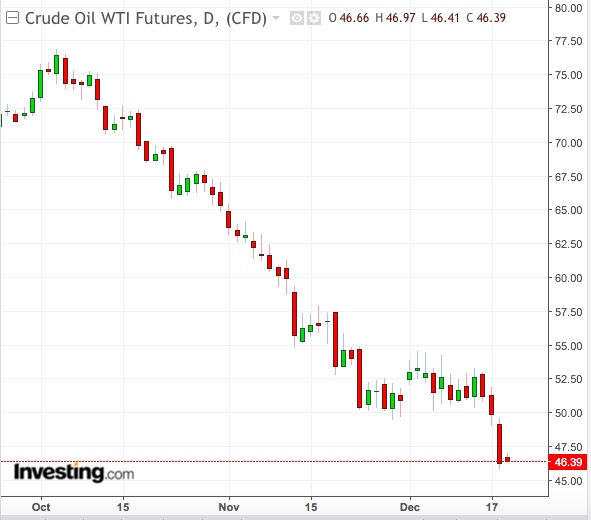Khalid al-Falih had probably expected oil prices to continue falling through the holiday season and for a while into the new year, until his production cut plans took off. What the Saudi Energy Minister might have not anticipated is the mayhem into which the market has descended.
Crude oil has lost nearly $6 per barrel since the Saudi-led Organization of the Petroleum Exporting Countries (OPEC) announced on December 7 that Russia and other non-member allies will join the cartel in cutting 1.2 million barrels per day (bpd) of supply over the next six months, beginning January.
Considering the market had dropped nearly $25 per barrel in the two months running up to that OPEC decision, the losses of the past two weeks might seem relatively small.
Price Plunge Of 40% In Just Over 2 Months

Of course, when taken together, the loss of $30 per barrel from early October's four-year highs of nearly $77 for US West Texas Intermediate WTI crude and almost $87 for UK Brent was quite staggering.
But more than that 40 percent loss, what the few oil bulls left in this new bear market dread is where prices could go next. Heading into the OPEC meeting, the fear was over oil breaking below $50 per barrel.
But after Tuesday’s 7 percent slide—the third time the market plunged that much in a day over the past four weeks—it was on whether it could even stay above $40. The last time oil got down to such levels was in August 2016, during the first round of the US shale glut crisis.
Russian, Saudis Join US In Overproducing
Adam Sarhan, founder of New York-based global markets fund 50 Park Investments, is bracing himself for another such eventuality as the current glut is caused not just by shale oil but also record Saudi and Russian production.
Worries of a global recession provided another layer of fear for investors, said Sarhan, adding:
“Oil bulls may shudder at the thought of the market getting below $40. But many forget that we traded as low as nearly $25 during the first round of the shale crisis.
In an extreme bear market like what we have now, people will shut out all the good news and focus on what drives the selling. So, we could get to the $30s, but there must be commensurate deterioration in fundamentals, technicals and the global economy.”
Such deterioration may be underway, given the new highs reported this week across US, Saudi and Russian crude production.
The US Energy Information Administration (IEA) said in its monthly drilling report on Monday that oil production from the seven major US shale basins was expected to surpass 8 million bpd by the end of the year. The United States is already the world's largest crude producer, with a peak output of 11.7 million bpd and an average of 10.9 million bpd this year. For 2019, the EIA has forecast an average of 12.1 million bpd—an increase of 1.2 million bpd over this year that, in theory, nullifies the OPEC plan to cut supply over the next six months.
The EIA data aside, Reuters reported on Tuesday that Russia pumped a record 11.42 million bpd this year. Saudi Arabia's own crude exports in October rose to 7.7 million barrels per day from 7.433 million bpd in September, official data showed.
Combined, these figures offset positive news such as the force majeure on nearly 385,000 bpd declared by Libya's National Oil Company (NOC) on two oilfields after seizure by militants of the El Sharara, the country's largest oilfield. Also discounted was a Bloomberg report that Russian Energy Minister Alexander Novak planned to meet with executives from local oil companies on Wednesday to discuss Russia’s plans to cut 228,000 bpd within the first quarter of 2019.
Global Recession Fears Add To Mix
Oil has also been pummeled by a wobbly US stock market, China’s worst retail sales performance in 15 years and Brexit struggles that could leave the British economy in its most vulnerable state ever, without EU support.
Dominick Chirichella of the Energy Management Institute in New York said:
“Not only is the trading community bearish, so is a growing number of investors and fund managers who now expect the global economy to weaken and translate into a slowdown in oil demand in 2019.”
But even if the news in oil isn’t bad, the selling streak is likely to persist for for two reasons: the resurgence of algorithmic trading models that have taken the place of human traders, and the fact that many of the latter group are vacationing this time of year, making for the thinner trading volumes typical for the holiday season. Like self-fulfilling prophecies that feed off each other, the computer-driven trading models seek out new technical lows that can be breached while the thinner volume exaggerates the impact of each bearish trade. The result: selling begets selling.
Algos Making It Worse
Scott Shelton, analyst and broker for ICAP in Durham, North Carolina, said there is a lack of willing buyers in the market overall.
“Which is probably the larger issue, as the algos smell that out and continue to generate weakness to stop out even the smallest of longs...The market is piling on the pain, though who is left from the long side after two months is a mystery to me."
Phil Davis of PSW Investments in New York isn’t one, for sure, having lost money buying oil on the dips a few times the past two months. He said:
"It's too crazy to be involved in this market. I'm not short, neither long.”
Like Sarhan, Davis wouldn't rule out WTI testing $40 before the year-end despite it being the market’s bedrock support. He added:
"Oil is getting no respect whatsoever at this stage and we've totally lost control of the narrative."
